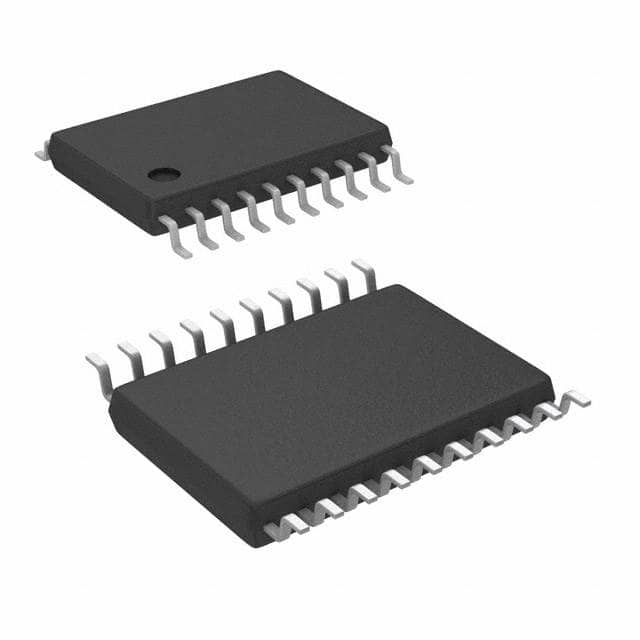Viz Specifikace pro podrobnosti o produktu.

74LVQ574TTR
Product Overview
Category
The 74LVQ574TTR belongs to the category of integrated circuits (ICs).
Use
This IC is commonly used in digital electronics for various applications such as data storage, signal processing, and communication systems.
Characteristics
- Low-voltage operation: The 74LVQ574TTR operates at a low voltage, typically around 2.5V to 3.6V, making it suitable for battery-powered devices.
- High-speed performance: It offers fast switching speeds, enabling efficient data processing and transmission.
- Durable package: The IC is housed in a small outline transistor (SOT) package, which provides protection and ease of handling during assembly.
Package and Quantity
The 74LVQ574TTR is available in a tape and reel packaging format, with a quantity of 2500 units per reel.
Specifications
- Logic family: LVQ
- Number of bits: 8
- Input/output type: Tri-state
- Supply voltage range: 2.5V to 3.6V
- Operating temperature range: -40°C to +85°C
- Propagation delay: <10 ns
- Output current: ±24 mA
Pin Configuration
The 74LVQ574TTR has a total of 20 pins, each serving a specific function. Here is the detailed pin configuration:
- GND (Ground)
- D0 (Data input 0)
- D1 (Data input 1)
- D2 (Data input 2)
- D3 (Data input 3)
- D4 (Data input 4)
- D5 (Data input 5)
- D6 (Data input 6)
- D7 (Data input 7)
- OE (Output enable)
- Q0 (Output 0)
- Q1 (Output 1)
- Q2 (Output 2)
- Q3 (Output 3)
- Q4 (Output 4)
- Q5 (Output 5)
- Q6 (Output 6)
- Q7 (Output 7)
- VCC (Power supply)
- GND (Ground)
Functional Features
The 74LVQ574TTR is a flip-flop-based octal D-type latch with tri-state outputs. It provides the following functional features:
- Data storage: The IC can store data on its eight inputs and retain it until a new input is received.
- Tri-state outputs: The outputs can be enabled or disabled using the output enable (OE) pin, allowing multiple devices to share a common bus without interference.
- High-speed operation: With its low propagation delay, the IC ensures efficient data processing and transmission.
Advantages and Disadvantages
Advantages
- Low-voltage operation makes it suitable for battery-powered devices.
- Tri-state outputs allow for efficient bus sharing.
- High-speed performance enables fast data processing.
Disadvantages
- Limited voltage range of operation (2.5V to 3.6V).
- Not suitable for high-power applications due to limited output current.
Working Principles
The 74LVQ574TTR operates based on flip-flop logic. When the output enable (OE) pin is active, the inputs are latched and stored in the internal memory. The stored data remains unchanged until a new input is received. The tri-state outputs allow the IC to control the flow of data onto a shared bus, preventing conflicts between multiple devices.
Application Field Plans
The 74LVQ574TTR finds applications in various fields, including:
- Microcontrollers: Used for interfacing with external devices and expanding input/output capabilities.
- Communication systems: Enables data storage and transmission in networking equipment, such as routers and switches.
- Data acquisition systems: Facilitates the capture and processing of analog signals into digital form.
Alternative Models
For similar functionality and performance, alternative models to the 74LVQ574TTR include:
- SN74LV574A: Manufactured by Texas Instruments, this IC offers octal D-type flip-flops with tri-state outputs.
- MC74LVX574: Produced by ON Semiconductor, it provides octal edge-triggered D-type flip-flops with tri-state outputs.
These alternative models can be considered based on specific project requirements and availability.
In conclusion, the 74LVQ574TTR is a versatile integrated circuit that offers low-voltage operation, high-speed performance, and tri-state outputs. Its applications span across various fields, including microcontrollers, communication systems, and data acquisition. While it has certain limitations, alternative models are available to suit different project needs.
Seznam 10 běžných otázek a odpovědí souvisejících s aplikací 74LVQ574TTR v technických řešeních
Sure! Here are 10 common questions and answers related to the application of 74LVQ574TTR in technical solutions:
Question: What is the 74LVQ574TTR?
- Answer: The 74LVQ574TTR is a type of octal D-type flip-flop with 3-state outputs, commonly used in digital circuits.Question: What is the operating voltage range of the 74LVQ574TTR?
- Answer: The operating voltage range of the 74LVQ574TTR is typically between 1.65V and 5.5V.Question: How many flip-flops are there in the 74LVQ574TTR?
- Answer: The 74LVQ574TTR consists of 8 individual flip-flops, making it an octal flip-flop.Question: What is the maximum clock frequency supported by the 74LVQ574TTR?
- Answer: The maximum clock frequency supported by the 74LVQ574TTR is typically around 200 MHz.Question: Can the 74LVQ574TTR be used for bidirectional data transfer?
- Answer: No, the 74LVQ574TTR is not designed for bidirectional data transfer. It is primarily used for unidirectional data storage and retrieval.Question: What is the power consumption of the 74LVQ574TTR?
- Answer: The power consumption of the 74LVQ574TTR is relatively low, making it suitable for battery-powered applications. The exact power consumption depends on the operating conditions.Question: Does the 74LVQ574TTR have any built-in protection features?
- Answer: Yes, the 74LVQ574TTR has built-in protection against electrostatic discharge (ESD) and excessive voltage levels.Question: Can the 74LVQ574TTR be cascaded to increase the number of flip-flops?
- Answer: Yes, multiple 74LVQ574TTR chips can be cascaded together to increase the number of flip-flops in a circuit.Question: What is the typical propagation delay of the 74LVQ574TTR?
- Answer: The typical propagation delay of the 74LVQ574TTR is around 5 ns, but it can vary depending on the specific operating conditions.Question: Are there any recommended applications for the 74LVQ574TTR?
- Answer: The 74LVQ574TTR is commonly used in various digital systems, such as data storage, address decoding, and bus interfacing.
Please note that the answers provided here are general and may vary depending on the specific datasheet and manufacturer's specifications for the 74LVQ574TTR.

